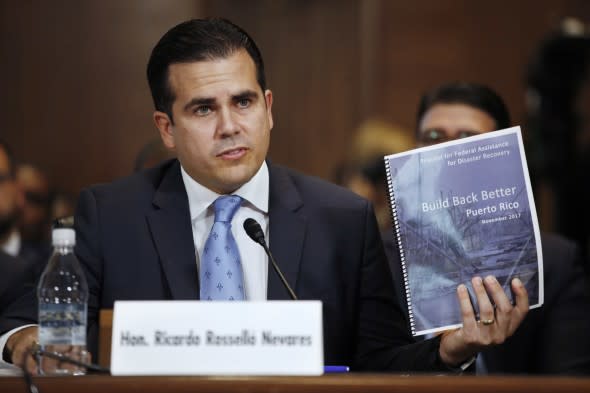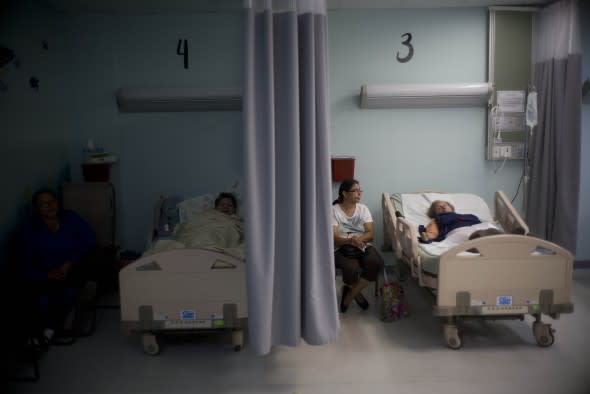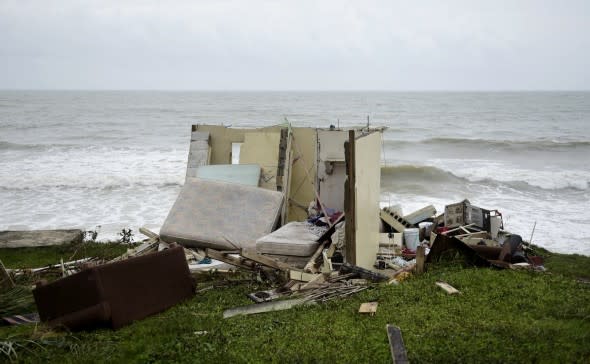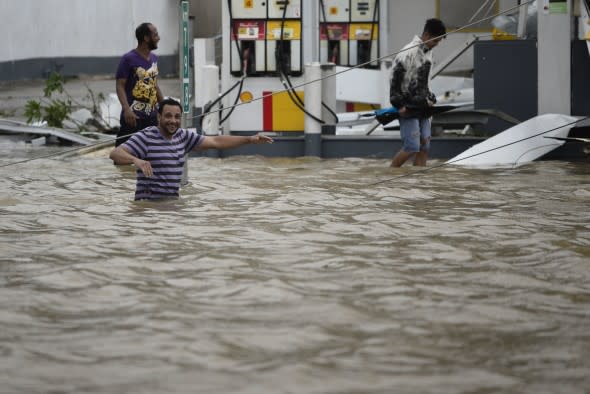Puerto Rico governor orders review of deaths since Maria, acknowledging official count is likely low

Puerto Rico Gov. Ricardo Rossello, speaks during a Senate Committee on Energy and Natural Resources hearing on hurricane recovery, Tuesday, Nov. 14, 2017, on Capitol Hill in Washington. (AP Photo/Jacquelyn Martin)
On Monday, Dec. 18, Puerto Rico Governor Ricardo Rosselló ordered that every death on the island since Hurricane Maria be reviewed, according to The New York Times.
"This is about more than numbers, these are lives: real people, leaving behind loved ones and families," Rosselló said in a statement.
The governor acknowledged that the death toll "may be higher than the official count certified to date."
The recount order follows numerous investigative reports that estimated the death toll to much higher than the official count of 64.
Hurricane Maria devastated United States territory Puerto Rico near the end of September. The storm wreaked havoc throughout the island, cutting water and power services, damaging infrastructure and causing deaths throughout the island.
However, the exact number of deaths caused by Maria remains largely uncertain.
The Puerto Rico government's official death toll from Maria is 64. However, numerous news outlets and other sources estimate the death toll to be between 400 and 1,000, with some estimating it to be over 1,000.

In this Thursday, Sept. 28, 2017 photo, patients lie in their beds at hospital in Catano, Puerto Rico. In Hurricane Maria's wake, hospitals and their employees are wrestling with the same shortages of basic necessities as everyone else. (AP Photo/Ramon Espinosa)
The death toll statistic is misleading, former Puerto Rico Senator Ramón Luis Nieves told members of Congress at a hearing on Nov. 2. Recent reports state that the government authorized about 1,000 cremations.
"Dozens of friends have shared with me countless stories of their elderly loved ones dying as a result of the lack of electricity in their homes, hospitals and care centers," Nieves said.
The actual death toll has not been properly disclosed by the Puerto Rico government, according to Nieves.
Several investigative reports highlight the low death toll estimate
BuzzFeed News reported on Oct. 27 that 911 bodies were cremated before being inspected by medical examiners to determine if the storm was related to the death.
The government later said that all of those people died of "natural causes." However, none of the bodies were examined to be determined if they should be included in the official death toll.
CNN published an investigative report on Nov. 20. The news company surveyed 112 funeral homes, about half of the island's total, to ask about possible hurricane-related deaths that may be excluded from the official death toll.
Funeral home directors said they had seen 499 deaths in the month after the storm. They claimed these deaths were related to Maria and its aftermath.
However, funeral home directors cannot legally classify deaths as hurricane-related, as they are not trained to conduct autopsies. Only one forensics office on the island can do that, according to an updated CNN report.
Therefore, the funeral reports are largely subjective. However, the funeral homes do have access to death certificates and are able to speak with families about the circumstances of deaths.
Two social science researchers, Alexis Stantos and Jeffrey Howard, show that the actual death count may be closer to 1,085, according to Vox.
The researchers calculated average monthly deaths in Puerto Rico from 2010 through 2016. They compared the historical averages for September and October of the past seven years to the total number of September and October 2017 deaths recently reported by the Puerto Rico Department of Public Safety.
They found that in September 2017, there were 518 more deaths than the recent historical average for September. There were 567 more deaths in October 2017 than the recent historical average for October.
The total is 1,085 deaths likely linked to the hurricane in just September and October.

A completely ruined house is seen in El Negro community a day after the impact of Hurricane Maria, in Puerto Rico, Thursday, September 21, 2017. (AP Photo/Carlos Giusti)
Hurricane death definition linked to confusion over total fatalities
Some of the undercounting has been linked to confusion about what should classify as a hurricane fatality.
The Puerto Rican government says indirect deaths count. Indirect deaths include events in which a person likely would be alive if not for the storm and its aftermath.
Some examples of indirect deaths included on the official list are three suicides and a few heart attacks. Another indirect death included a person that fell off the roof while repairing a storm-damaged home, according to CNN.
The Federal Emergency Management Agency (FEMA) told Vox that it had received 2,339 applications for burial and funeral assistance in Puerto Rico since Maria hit, as of Nov. 6.
FEMA determined that 537 of those burial applications were not related to Maria, including people who erroneously asked for funeral assistance while seeking other FEMA aid.
It remains largely unclear how many of those applications are seeking help to bury those who died from the storm or to repair grave sites disturbed by the hurricane.

People walk next to a gas station flooded and damaged by the impact of Hurricane Maria, which hit the eastern region of the island, in Humacao, Puerto Rico, Wednesday, Sept. 20, 2017. (AP Photo/Carlos Giusti)
Lawmakers stress the importance of an accurate death toll
On Oct. 19, 13 U.S. Senators urged the Trump administration to ensure the count is accurate in a letter.
"An accurate death toll is important for understanding the true severity of the situation on the ground, for recognizing potential problems and vulnerabilities, for assessing the quality of the disaster response so far, and for setting policy going forward," the letter reads.
